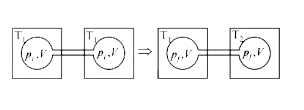Initially bulb "a" contained oxygen gas at 27∘C and 950 mm of Hg and bulb "B" contained neon gas at 27∘C and 900 mm of Hg. These bulbs are connected by a narrow tube of negligible volume equipped with a stopcock and gases were allowed to mix-up freely. The pressure obtained in the combined system was found to be 910 mm of Hg.

If volume of bulb B was measured to be 10 L, then find the volume of oxygen gas present initially in bulb "A" .
The correct Answer is:4
nT=n1+n2
910×(10+V)RT=950×VRT+900×10RT
V=4L
Topper's Solved these Questions
- GASEOUS STATEBOOK - NARENDRA AWASTHICHAPTER - GASEOUS STATEEXERCISE - Level 1 (Q.31 To Q.60)
1 Videos
- GASEOUS STATEBOOK - NARENDRA AWASTHICHAPTER - GASEOUS STATEEXERCISE - Level 1 (Q.121 To Q.150)
1 Videos
- ELECTROCHEMISTRYBOOK - NARENDRA AWASTHICHAPTER - ELECTROCHEMISTRYEXERCISE - Level 3 - Subjective Problems
1 Videos
- IONIC EEQUILIBRIUMBOOK - NARENDRA AWASTHICHAPTER - IONIC EEQUILIBRIUMEXERCISE - Exercise
196 Videos
Similar Questions
Knowledge Check
Consider the adjacent diagram. Initially, flask A contained oxygen gas at 27∘C and 950mm of Hg, and flask B contained neon gas at 27∘C and 900mm. Finally, two flask were joined by means of a narrow tube of negligible volume equipped with a stopcock and gases were allowed to mixup freely. The final pressure in the combined system was found to be 910mm of Hg.

If flask B were heated to 127∘C, maintaining flask A at constant temperature of 27∘C, final pressure (in mmHg) in the combined system would have beenA1007B1250C1137.5D1990Consider the adjacent diagram. Initially, flask A contained oxygen gas at 27∘C and 950mm of Hg, and flask B contained neon gas at 27∘C and 900mm. Finally, two flask were joined by means of a narrow tube of negligible volume equipped with a stopcock and gases were allowed to mixup freely. The final pressure in the combined system was found to be 910mm of Hg.

Which of the following statements concerning oxygen and neon gas is true in the begining, when the stopcock was just opened?AO2 moved at faster rate toward flask B.BNe moved at faster rate towards flask A.CBoth O2 and Ne gases moves at equal rate.DInsufficient information to compare the rate of effusion.Consider the adjacent diagram. Initially, flask A contained oxygen gas at 27∘C and 950mm of Hg, and flask B contained neon gas at 27∘C and 900mm. Finally, two flask were joined by means of a narrow tube of negligible volume equipped with a stopcock and gases were allowed to mixup freely. The final pressure in the combined system was found to be 910mm of Hg.

What is the correct relationship between volumes of the two flasks?AVB=2VABVB=4VACVB=5VADVB=5.5VA
Calculate RMS velocity of ethane at 27∘ C and 720 mm of Hg pressure.
View SolutionCalculate the volume occupied by 7gCO at 27∘C and 750mm Hg .
View Solution2gm of O2 at 27∘C and 76mm of Hg pressure has volume
View SolutionTwo closed bulbs of equal volume (V) containing an ideal gas initially at pressure pi and temperature T1 are connected through a narrow tube of negligible volume as shown in the figure below. The temperature of one of the bulbs is then raised to T2. The final pressure pf is:

View SolutionTwo closed bulbs of equal volume (V) containing an ideal gas initially at pressure Pi and temperature T1 are connected through a narrow tube of negligible volume as shown in the figure below. The temperature of one of the bulbs is then raised to T2. The final pressure Pf is :

View Solution
